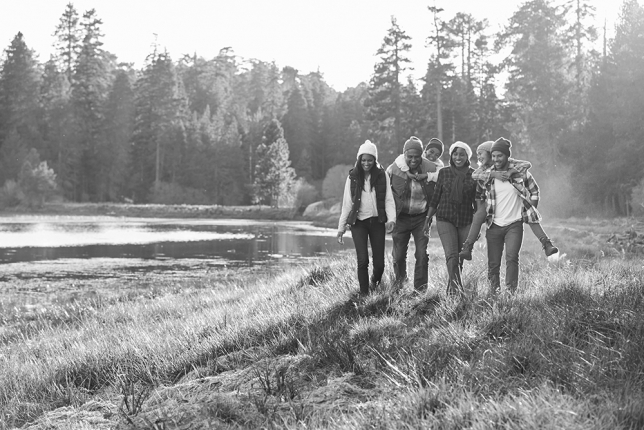Experiences in nature are deeply social

Nature experienced alone can be a powerful thing, and the opportunity for solitude is important for many. But Americans are clear: When they talk about their most memorable moments and their special places outdoors, they nearly always involve other people. Americans make time for nature when they have the social support to do so and when the activities involve their friends and family. Developing strategies for addressing the interest–action gap must begin with the fact that meaningful moments in nature occur — and are remembered — because they connect people to one another.
Assure adults and children that time in nature can be (and even ought to be) social
While most adults reveal that they spend time in nature with others, many nevertheless describe experiences in nature as requiring some amount of solitude to be “authentic.” The default design and promotion of programs and natural areas should nurture and portray the sociability of participants and opportunities to forge connections with nature together. This may in turn alleviate the concerns of people who are wary of being alone outdoors.
Recruit pre-existing groups to programs
Instead of merely inviting individuals to participate in a program or activity, recruit groups of people who are already connected to one another through a common interest, activity, or lifestyle. Doing so boosts the likelihood that people who would not normally participate will feel more comfortable doing so by lowering the social risks of isolation and helping to lower fears of not fitting in. Also, by increasing the social familiarity of the setting or activity, participants can more readily focus on building familiarity and comfort with the natural environment.
Reach adults through children
Our research shows that adults who are making time to share their interest in nature with children themselves tend to spend more time outdoors, rate their interests in nature as among their more or most enjoyable interests, and report higher interest in exploring the outdoors. In other words, the act of socializing children to have interest in, respect for, and commitment to nature appears to have a reciprocal effect on the adults who do the socializing. Thus, programs should encourage parents and other trusted adults to participate in activities together with children. We see particular potential among adults who are over 50 years old: this group was most concerned about younger generations and reported having additional time for their interest in nature, yet was much less likely to indicate sharing their interests in nature with children. Cross-generational programs could promote conservation activities not just among younger generations, but also among older ones. Programs could encourage greater adult participation outdoors with children and friends, emphasizing that these can be relatively simple, close-to-home activities. Boosting adult participation could also have the effect of diminishing parental concerns about their child’s safety.
Support mentorship that extends beyond the parent–child relationship
While parents play an important role in influencing their children’s views and connections to the natural world, there are other people in children’s lives that can also support or play this role. Other influential figures that influence how people relate to the natural world included friends, grandparents and other family members, and teachers. These findings indicate the need to support not only parent–child mentorship, but also friend–friend, grandparent–child, conservation professional–adult, and so on.
